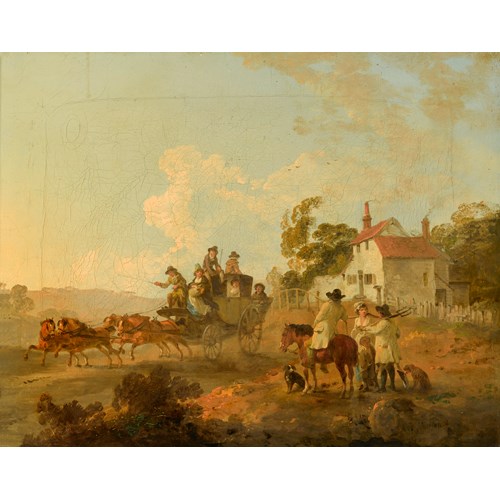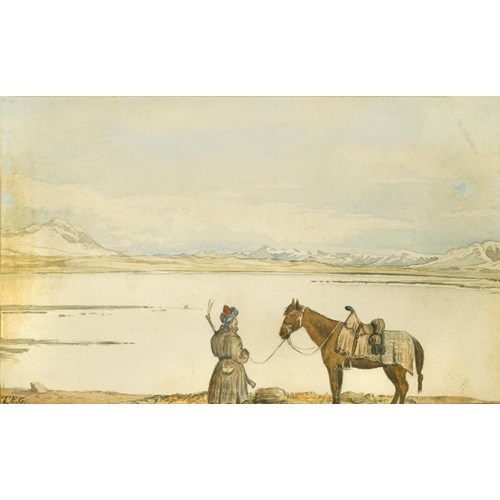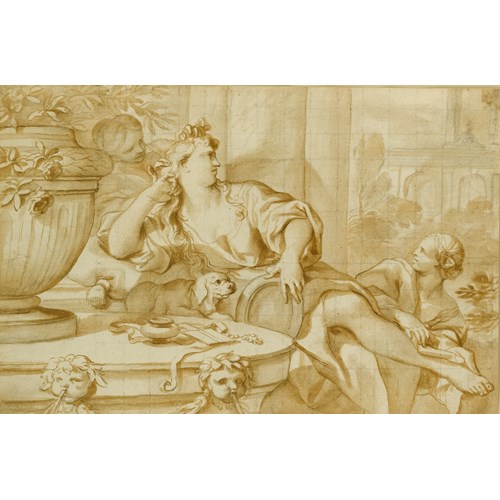Marketplace
The Runaway Wagon
James Ward
The Runaway Wagon
Period 1750-1850, 18th century, 19th century
Origin England
Medium Oil on canvas
Dimension 61 x 76.2 cm (24 x 30 inches)
An exhilarating and urgent chase is depicted in The Runaway Wagon as a man desperately pursues his wagon pulled by two horses as they speed away in a full gallop. James Ward is best known for his accomplished animal studies although he also expertly captured people and landscapes; in this composition, he brings all three components together to create an engaging scene. The tumultuous energy of the scene is heightened by the dark and stormy clouds in the sky and the shadowy ground beneath, and Ward’s vigorous brush strokes and strong colours add to the drama.
Central to the composition are two horses showing off their powerful muscles and lustrous coats as they strain to escape the burden of the wagon. The lead horse is turned away but the second horse turns his finely formed head to challenge the viewer. Ward often painted animals in a state of agitation or movement and his preparatory drawings such as Studies of a Horse in Motion in The Fitzwilliam Museum, Cambridge, reveal his interest in capturing the specifics of anatomy and the range of movements that were necessary for executing a convincing animal painting.
Chaos abounds in The Runaway Wagon, and can be seen in the details of the basket and bundles about to tumble to the ground, and the pigs scurrying from underneath the wagon in fright. A man, presumably the owner of the wagon, runs after it in a state of dishevelled frenzy, while on the left of the composition another man appears terrified as he hastens to close the gate and halt the oncoming horses. Down the path away from the village, a rider can be seen galloping by on his steed, which may explain the commotion that prompted the wagon horses to bolt. Meanwhile, the sky grows dark and threatening and the wind has picked up as can be seen by the movement in the trees. In its heightened emotion and spirited portrayal of untamed nature, The Runaway Wagon exemplifies the ideals of Romanticism.
Ward had a lengthy and prolific career establishing himself as one of the most talented painters of animals, portraits and landscapes in Regency England. He frequently exhibited at the British Institution and the Royal Academy of Arts, London. Ward was instructed in the art of engraving by his brother William Ward and John Raphael Smith and developed a successful career as a mezzotinter before turning to oil painting around 1790. Traditionally, the first phase of Ward’s painting career is thought to have lasted until c. 1803 and consisted mostly of genre scenes, influenced by the work of his brother-in-law, George Morland. Post 1803, a shift in Ward’s style can be detected when his compositions began to emulate Rubens.
Shortly before 1810, Ward began painting characteristically proud and noble portraits of thoroughbreds and blood horses posed in expansive landscapes. He gained particular recognition for these works, leading the Sporting Magazine to describe him as ‘the first of English animal painters now living’1. Following this success, Ward was elected to the R.A. in 1811. In the next decade, Ward completed a number of major paintings depicting landscapes and livestock. He devoted most of the years from 1815 to 1821 to executing the Waterloo Allegory, a composition of enormous size commissioned by the British Institution. The work, now lost, was critically and financially unsuccessful and its negative reception may have added to Ward’s increasing disillusionment with the art world. He retired to a cottage in Cheshunt, Hertfordshire, in 1830, although he continued to exhibit in London. His paintings of this latter period, although ostensibly still animal portraits, often have a religious subtext or incorporate moral messages and commentary on the human condition. Ward continued to paint until 1855 when he suffered from a stroke.
1 Sporting Magazine, 1811, p.265.
Central to the composition are two horses showing off their powerful muscles and lustrous coats as they strain to escape the burden of the wagon. The lead horse is turned away but the second horse turns his finely formed head to challenge the viewer. Ward often painted animals in a state of agitation or movement and his preparatory drawings such as Studies of a Horse in Motion in The Fitzwilliam Museum, Cambridge, reveal his interest in capturing the specifics of anatomy and the range of movements that were necessary for executing a convincing animal painting.
Chaos abounds in The Runaway Wagon, and can be seen in the details of the basket and bundles about to tumble to the ground, and the pigs scurrying from underneath the wagon in fright. A man, presumably the owner of the wagon, runs after it in a state of dishevelled frenzy, while on the left of the composition another man appears terrified as he hastens to close the gate and halt the oncoming horses. Down the path away from the village, a rider can be seen galloping by on his steed, which may explain the commotion that prompted the wagon horses to bolt. Meanwhile, the sky grows dark and threatening and the wind has picked up as can be seen by the movement in the trees. In its heightened emotion and spirited portrayal of untamed nature, The Runaway Wagon exemplifies the ideals of Romanticism.
Ward had a lengthy and prolific career establishing himself as one of the most talented painters of animals, portraits and landscapes in Regency England. He frequently exhibited at the British Institution and the Royal Academy of Arts, London. Ward was instructed in the art of engraving by his brother William Ward and John Raphael Smith and developed a successful career as a mezzotinter before turning to oil painting around 1790. Traditionally, the first phase of Ward’s painting career is thought to have lasted until c. 1803 and consisted mostly of genre scenes, influenced by the work of his brother-in-law, George Morland. Post 1803, a shift in Ward’s style can be detected when his compositions began to emulate Rubens.
Shortly before 1810, Ward began painting characteristically proud and noble portraits of thoroughbreds and blood horses posed in expansive landscapes. He gained particular recognition for these works, leading the Sporting Magazine to describe him as ‘the first of English animal painters now living’1. Following this success, Ward was elected to the R.A. in 1811. In the next decade, Ward completed a number of major paintings depicting landscapes and livestock. He devoted most of the years from 1815 to 1821 to executing the Waterloo Allegory, a composition of enormous size commissioned by the British Institution. The work, now lost, was critically and financially unsuccessful and its negative reception may have added to Ward’s increasing disillusionment with the art world. He retired to a cottage in Cheshunt, Hertfordshire, in 1830, although he continued to exhibit in London. His paintings of this latter period, although ostensibly still animal portraits, often have a religious subtext or incorporate moral messages and commentary on the human condition. Ward continued to paint until 1855 when he suffered from a stroke.
1 Sporting Magazine, 1811, p.265.
Period: 1750-1850, 18th century, 19th century
Origin: England
Medium: Oil on canvas
Signature: Signed and inscribed ‘I.WARD.x/Paddington’ (on the wagon).
Dimension: 61 x 76.2 cm (24 x 30 inches)
More artworks from the Gallery









